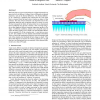Free Online Productivity Tools
i2Speak
i2Symbol
i2OCR
iTex2Img
iWeb2Print
iWeb2Shot
i2Type
iPdf2Split
iPdf2Merge
i2Bopomofo
i2Arabic
i2Style
i2Image
i2PDF
iLatex2Rtf
Sci2ools
HAPTICS
2009
IEEE
2009
IEEE
Discrimination of thermal diffusivity
Materials such as wood or metal which are at equal temperatures are perceived to be of different ‘coldness’ due to differences in thermal properties, such as the thermal diffusivity. The thermal diffusivity of a material is a parameter that controls the rate with which heat is extracted from the hand when it touches an object of that material. This rate of heat extraction is an important cue for distinguishing materials and recognising objects by means of touch. We have measured the ability of human observers to discriminate between different rates of heat extraction. This was done using a device that displayed different transient temperature profiles to the finger. In different conditions, subjects were repeatedly asked to select the faster-cooling of two stimuli. The discrimination threshold was around 43 % of the extraction rate. A rate that was twice as slow also yielded twice the absolute discrimination threshold. When we halved the temperature difference between beginning ...
| Added | 21 May 2010 |
| Updated | 21 May 2010 |
| Type | Conference |
| Year | 2009 |
| Where | HAPTICS |
| Authors | Wouter M. Bergmann Tiest, Astrid M. L. Kappers |
Comments (0)

